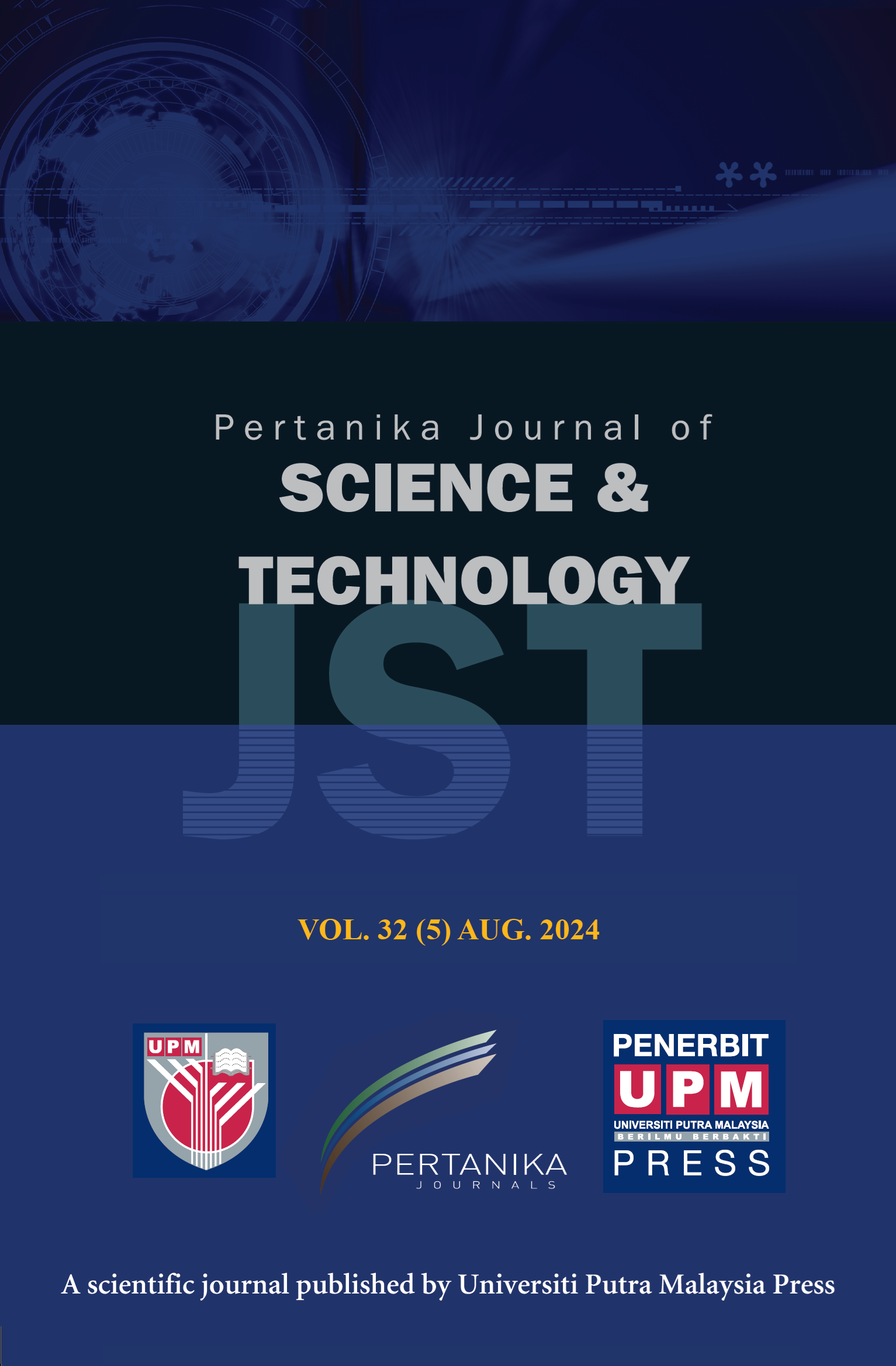PERTANIKA JOURNAL OF SCIENCE AND TECHNOLOGY
e-ISSN 2231-8526
ISSN 0128-7680
J
J
Pertanika Journal of Science & Technology, Volume J, Issue J, January J
Keywords: J
Published on: J
J
-
Adoko, M. Y., Sina, H., Amogou, O., Agbodjato, N. A., Noumavo, P. A., Aguégué, R. M., Assogba, S. A., Adjovi, N. A., Dagbénonbakin, G., Adjanohoun, A., & Baba-Moussa, L. (2021). Potential of biostimulants based on PGPR rhizobacteria native to Benin’s soils on the growth and yield of maize (Zea mays L.) under greenhouse conditions. Open Journal of Soil Science, 11(3), 177-196. https://doi.org/10.4236/ojss.2021.113010
-
Akhtar, N., Naveed, M., Khalid, M., Ahmad, N., Rizwan, M., & Siddique, S. (2018). Effect of bacterial consortia on growth and yield of maize grown in Fusarium infested soil. Soil and Environment, 37(1), 35-44. https://doi.org/10.25252/SE/18/872
-
Ali, B., Wang, X., Saleem, M. H., Sumaira., Hafeez, A., Afridi, M. S., Khan, S., Zaib-Un-Nisa., Ullah I., do Amaral Júnior A. T., Alatawi, A., & Ali, S. (2022). PGPR-mediated salt tolerance in maize by modulating plant physiology, antioxidant defense, compatible solutes accumulation and bio-surfactant producing genes. Plants, 11(3), 345. https://doi.org/10.3390/plants11030345
-
Aslam, F., & Ali, B. (2018). Halotolerant bacterial diversity associated with Suaeda fruticosa (L.) Forssk. improved growth of maize under salinity stress. Agronomy, 8(8), 131. https://doi.org/10.3390/agronomy8080131
-
Bhattacharyya, P. N., & Jha, D. K. (2012). Plant growth-promoting rhizobacteria (PGPR): Emergence in agriculture. World Journal of Microbiology and Biotechnology, 28, 1327–1350. https://doi.org/10.1007/s11274-011-0979-9
-
Devi, K. A., Pandey, P., & Sharma, G. D. (2016). Plant growth-promoting endophyte Serratia marcescens AL2-16 enhances the growth of Achyranthes aspera L., a medicinal plant. HAYATI Journal of Biosciences, 23(4), 173–180. https://doi.org/10.1016/j.hjb.2016.12.006
-
Efthimiadou, A., Katsenios, N., Chanioti, S., Giannoglou, M., Djordjevic, N., & Katsaros, G. (2020). Effect of foliar and soil application of plant growth promoting bacteria on growth, physiology, yield and seed quality of maize under Mediterranean conditions. Scientific Reports, 10, 21060. https://doi.org/10.1038/s41598-020-78034-6
-
Glick, B. R. (2012). Plant growth-promoting bacteria: Mechanisms and applications. Scientifica, 2012, 963401. https://doi.org/10.6064/2012/963401
-
Humphries, R., Campeau, S., Davis, T. E., Nagaro, K. J., LaBombardi, V. J., Franklin, S., Heimbach, L., & Dwivedi, H. P. (2021). Multicenter evaluation of ceftazidime-avibactam susceptibility testing of Enterobacterales and Pseudomonas aeruginosa on the Vitek 2 system. Journal of Clinical Microbiology, 59(3), e01870-20. https://doi.org/10.1128/jcm.01870-20
-
Ikhwan, A., Iriany, A., Ishartati, E., & Hasanah, F. (2021). Formulation of bacterial consortium for improvement growth and yield of maize (Zea mays L.). SAINS TANAH - Journal of Soil Science and Agroclimatology, 18(1), 89-97. http://doi.org/10.20961/stjssa.v18i1.46003
-
Ikhwan, A., Septia, E. D., & Novita, B. A. (2021). Molecular identification of potential rhizobacteria isolated from maize (Zea mays L.). In IOP Conference Series: Earth and Environmental Science (Vol. 985, No. 1, p. 012010). IOP Publishing. https://doi.org/10.1088/1755-1315/985/1/012010
-
Irfan, M., Zahir, Z. A., Asghar, H. N., Khan, M. Y., Ahmad, H. T., & Ali, Q. (2019). Effect of multi-strain bacterial inoculation with different carriers on growth and yield of maize under saline conditions. International Journal of Agriculture and Biology, 22, 1407-1414. https://doi.org/10.17957/IJAB/15.1215
-
Kämpfer, P., McInroy, J. A., Doijad, S., Chakraborty, T., & Glaeser, S. P. (2016). Kosakonia pseudosacchari sp. nov., an endophyte of Zea mays. Systematic and Applied Microbiology, 39(1), 1-7. https://doi.org/10.1016/j.syapm.2015.09.004
-
Katsenios, N., Andreou, V., Sparangis, P., Djordjevic, N., Giannoglou, M., Chanioti, S., Kasimatis, C.-N., Kakabouki, I., Leonidakis, D., Danalatos, N., Katsaros, G., & Efthimiadou, A. (2022). Assessment of plant growth promoting bacteria strains on growth, yield and quality of sweet corn. Scientific Reports, 12, 11598. https://doi.org/10.1038/s41598-022-16044-2
-
Malusà, E., Pinzari, F., & Canfora, L. (2016). Efficacy of biofertilizers: Challenges to improve crop production. In D. P. Singh, H. B. Singh, & R. Prabha (Eds), Microbial inoculants in sustainable agricultural productivity (pp. 17-40). Springer. https://doi.org/10.1007/978-81-322-2644-4_2
-
Mehta, S. K., Baheti, B. L., Rathore, B. S., & Nama, C. P. (2015). Botanicals - An effective tool for the management of maize cyst nematode, Heterodera zeae on maize (Zea mays L.). Journal of Biopesticides, 8(2), 62–67. http://doi.org/10.57182/jbiopestic.8.2.62-67
-
Odoh, C. K., Sam, K., Zabbey, N., Eze, C. N., Nwankwegu, A. S., Laku, C., & Dumpe, B. B. (2020). Microbial consortium as biofertilizers for crops growing under the extreme habitats. In A. N. Yadav, J. Singh, A. A. Rastegari, & N. Yadav (Eds.), Plant microbiomes for sustainable agriculture: Sustainable development and biodiversity (Vol. 25, pp. 381-424). Springer. https://doi.org/10.1007/978-3-030-38453-1_13
-
Olanrewaju, O. S., & Babalola, O. O. (2019). Bacterial consortium for improved maize (Zea mays L.) production. Microorganisms, 7(11), 519. https://doi.org/10.3390/microorganisms7110519
-
Onyia, C. O., Okoh, A. M., & Irene, O. (2020). Production of plant growth-promoting bacteria biofertilizer from organic waste material and evaluation of its performance on the growth of corn (Zea mays). American Journal of Plant Sciences, 11(2), 189-200. https://doi.org/10.4236/ajps.2020.112015
-
Seenivasagan, R., & Babalola, O. O. (2021). Utilization of microbial consortia as biofertilizers and biopesticides for the production of feasible agricultural product. Biology, 10(11), 1111. https://doi.org/10.3390/biology10111111
-
Sutio, G., Afifah, A. N., Maharani, R., & Basri, M. (2023). Serratia marcescens strain NPKC3_2_21 as endophytic phosphate solubilizing bacteria and entomopathogen: Promising combination approach as rice biofertilizer and biopesticide. Biodiversitas Journal of Biological Diversity, 24(2), 901-909.
-
Toribio-Jiménez, J., Rodriguez-Barrera, M., Hernandez-Florez, G., Ruvalcaba-Ledezma, J. C., Castellanos-Escazmilla, M., & Romero-Ramirez, Y. (2017). Isolation and screening of bacteria from Zea mays plant growth promoters. Revista Internacional de Contaminacion Ambiental, 33, 143–150. http://doi.org/10.20937/RICA.2017.33.esp01.13
-
Wong-Villarreal, A., Yañez-Ocampo, G., Hernández-Nuñez, E., Corzo-González, H., Giácoman-Vallejos, G., González-Sánchez, A., Gómez-Velasco, D., González, S. I. R., López-Baez, O., & Espinosa-Zaragoza, S. (2019). Bacteria from Jatropha curcas rhizosphere, degrades aromatic hydrocarbons and promotes growth in Zea mays. Open Agriculture, 4(1), 641-649. https://doi.org/10.1515/opag-2019-0066
ISSN 0128-7680
e-ISSN 2231-8526




